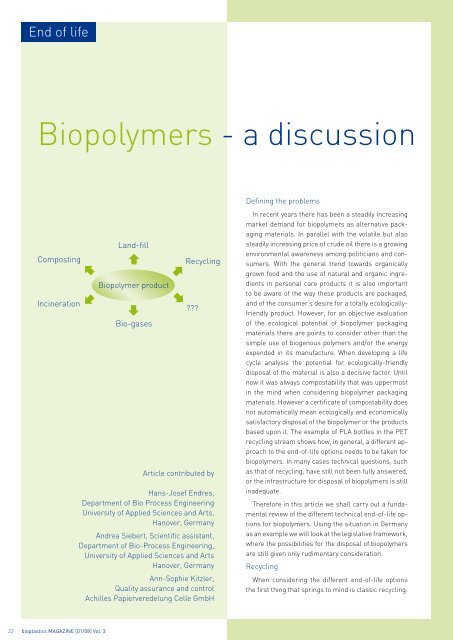01 | 2008
You also want an ePaper? Increase the reach of your titles
YUMPU automatically turns print PDFs into web optimized ePapers that Google loves.
End of life<br />
Biopolymers - a discussion<br />
Defining the problems<br />
Composting<br />
Incineration<br />
Land-fill<br />
Biopolymer product<br />
Bio-gases<br />
Recycling<br />
???<br />
Article contributed by<br />
Hans-Josef Endres,<br />
Department of Bio Process Engineering<br />
University of Applied Sciences and Arts,<br />
Hanover, Germany<br />
Andrea Siebert, Scientific assistant,<br />
Department of Bio-Process Engineering,<br />
University of Applied Sciences and Arts<br />
Hanover, Germany<br />
Ann-Sophie Kitzler,<br />
Quality assurance and control<br />
Achilles Papierveredelung Celle GmbH<br />
In recent years there has been a steadily increasing<br />
market demand for biopolymers as alternative packaging<br />
materials. In parallel with the volatile but also<br />
steadily increasing price of crude oil there is a growing<br />
environmental awareness among politicians and consumers.<br />
With the general trend towards organically<br />
grown food and the use of natural and organic ingredients<br />
in personal care products it is also important<br />
to be aware of the way these products are packaged,<br />
and of the consumer‘s desire for a totally ecologicallyfriendly<br />
product. However, for an objective evaluation<br />
of the ecological potential of biopolymer packaging<br />
materials there are points to consider other than the<br />
simple use of biogenous polymers and/or the energy<br />
expended in its manufacture. When developing a life<br />
cycle analysis the potential for ecologically-friendly<br />
disposal of the material is also a decisive factor. Until<br />
now it was always compostability that was uppermost<br />
in the mind when considering biopolymer packaging<br />
materials. However a certificate of compostability does<br />
not automatically mean ecologically and economically<br />
satisfactory disposal of the biopolymer or the products<br />
based upon it. The example of PLA bottles in the PET<br />
recycling stream shows how, in general, a different approach<br />
to the end-of-life options needs to be taken for<br />
biopolymers. In many cases technical questions, such<br />
as that of recycling, have still not been fully answered,<br />
or the infrastructure for disposal of biopolymers is still<br />
inadequate.<br />
Therefore in this article we shall carry out a fundamental<br />
review of the different technical end-of-life options<br />
for biopolymers. Using the situation in Germany<br />
as an example we will look at the legislative framework,<br />
where the possibilities for the disposal of biopolymers<br />
are still given only rudimentary consideration.<br />
Recycling<br />
When considering the different end-of-life options<br />
the first thing that springs to mind is classic recycling.<br />
22 bioplastics MAGAZINE [<strong>01</strong>/08] Vol. 3


















